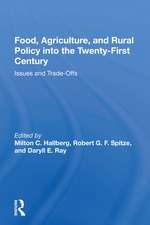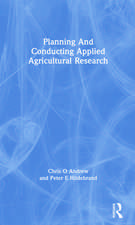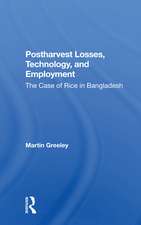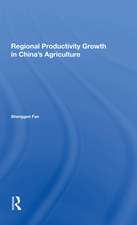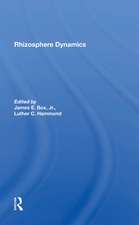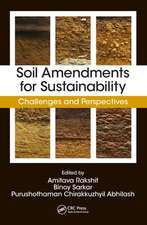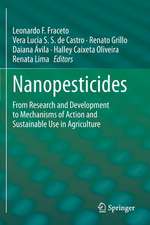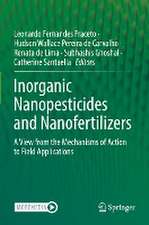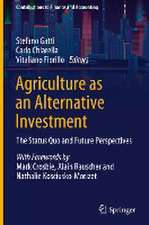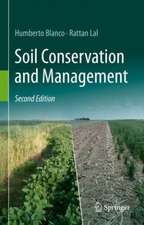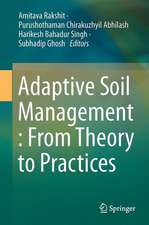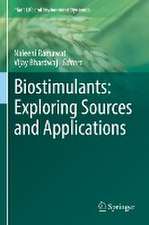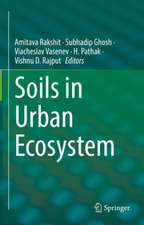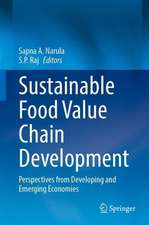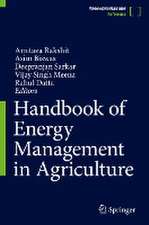Nutrient Use Efficiency: from Basics to Advances
Editat de Amitava Rakshit, Harikesh Bahadur Singh, Avijit Senen Limba Engleză Paperback – 14 oct 2016
| Toate formatele și edițiile | Preț | Express |
|---|---|---|
| Paperback (1) | 805.29 lei 38-44 zile | |
| Springer India – 14 oct 2016 | 805.29 lei 38-44 zile | |
| Hardback (1) | 964.23 lei 6-8 săpt. | |
| Springer India – 14 ian 2015 | 964.23 lei 6-8 săpt. |
Preț: 805.29 lei
Preț vechi: 1059.59 lei
-24% Nou
Puncte Express: 1208
Preț estimativ în valută:
154.11€ • 167.34$ • 129.45£
154.11€ • 167.34$ • 129.45£
Carte tipărită la comandă
Livrare economică 19-25 aprilie
Preluare comenzi: 021 569.72.76
Specificații
ISBN-13: 9788132235330
ISBN-10: 8132235339
Pagini: 440
Ilustrații: XXIII, 417 p. 57 illus., 29 illus. in color.
Dimensiuni: 178 x 254 mm
Ediția:Softcover reprint of the original 1st ed. 2015
Editura: Springer India
Colecția Springer
Locul publicării:New Delhi, India
ISBN-10: 8132235339
Pagini: 440
Ilustrații: XXIII, 417 p. 57 illus., 29 illus. in color.
Dimensiuni: 178 x 254 mm
Ediția:Softcover reprint of the original 1st ed. 2015
Editura: Springer India
Colecția Springer
Locul publicării:New Delhi, India
Cuprins
Chapter 1: Nutrient use efficiency in plants: an overview.- Part I: Nutrients as a Key Driver of Nutrient Use Efficiency.- Chapter 2: Soils and Inputs Management Options for Increasing Nutrient Use Efficiency.- Chapter 3: Nutrient and water use efficiency in soil: The influence of geological mineral amendments.- Chapter 4: Resource conserving techniques for improving nitrogen use-efficiency.- Chapter 5: Strategies for enhancing phosphorus efficiency in crop production systems.- Chapter 6: Efficiency of soil and fertilizer phosphorus use in time: a comparison between recovered struvite, FePO4-sludge, digestate, animal manure and synthetic fertilizer.- Chapter 7: Strategies for Enhancing Zinc Efficiency in Crop Plants.- Chapter 8: Nitrification inhibitors: classes and its use in nitrification management.- Part-II: Microbiological aspects of Nutrient Use Efficiency.- Chapter 9: Role of Microorganisms in Plant Nutrition and Health.- Chapter 10: Role of Cyanobacteria inNutrient Cycle and Use Efficiency in the Soil.- Chapter 11: Trichoderma improves nutrient use efficiency in crop plants.- Chapter 12: Bio-priming mediated nutrient use efficiency of crop species.- Chapter 13: Unrealized potential of seed biopriming for versatile agriculture.- Part-III: Molecular and physiological aspects of Nutrient Use Efficiency.- Chapter 14: Improving nutrient use efficiency by exploiting genetic diversity of crops.- Chapter 15: Micro RNA based approach to improve nitrogen use efficiency in plants.- Chapter 16: Biofortification for selecting and developing crop cultivars denser in iron and zinc.- Chapter 17: Understanding genetic and molecular bases of Fe and Zn accumulation towards development of micronutrient enriched maize.- Part-IV: Nutrient Use Efficiency of Crop Species.- Chapter 18: Nitrogen uptake and use efficiency in rice.- Chapter 19: Nutrient-use efficiency in Sorghum.- Chapter 20: Improving nutrient use efficiency in oilseeds Brassica.- Chapter21: Strategies for higher nutrient use efficiency and productivity in forage crops.- Chapter 22: Integrated nutrient management in potato for increasing nutrient use efficiency and sustainable productivity.- Part-V: Specialised Case Studies.- Chapter 23: Enhancing Nutrient Use Efficiencies in Rainfed Systems.- Chapter 24: Dynamics Of Plant Nutrients, Utilization And Uptake, And Soil Microbial Community In Crops Under Ambient And Elevated Carbon Dioxide.- Chapter 25: Phytometallophore Mediated Nutrient Acquisition by Plants.
Notă biografică
Amitava Rakshit, an IIT, Kharagpur alumnus is presently the faculty member in the Department of Soil Science and Agricultural Chemistry at Institute of Agricultural Sciences, Banaras Hindu University(IAS, BHU). Dr. Rakshit worked in the Department of Agriculture, Government of West Bengal in administration and extension roles. He has visited Norway, Finland, Denmark, France, Austria, Russia, Thailand, Egypt, Turkey pertaining to his research work and presentation. He was awarded with TWAS Nxt Fellow (Italy), Biovision Nxt Fellow (France), Darwin Now Bursary (British Council), Young Achiever Award and Best Teacher’s Award at UG and PG level (BHU & ICAR, New Delhi). He is serving as review college member of British Ecological Society, London since 2011. He has published 70 research papers, 15 book chapters, 28 popular articles, one manual and co authored five books.
Avijit Sen is presently Professor and Head in the Department of Agronomy, IAS, BHU. He has presented more than 40 research papers and delivered lectures in conferences/seminars/refresher courses within and outside the country besides handling 5 ad-hoc projects. Currently he is the Deputy Coordinator of the prestigious Special Assistance Programme awarded to the Department by UGC. He is recipient of CWSS Gold Medal 2013. With 33 years of experience, he has published more than 60 research papers and articles, and written 3 chapters of books till date.
Harikesh B. Singh is presently Professor of Mycology and Plant Pathology at IAS, BHU. He served State Agriculture University, Central University and CSIR Institute in teaching, research, and extension roles. In recognition of Prof. Singh’s scientific contributions and leadership in the field of plant pathology, he was honored with several prestigious awards, notable being, CSIR Prize for Biological Sciences, Vigyan Bharti Award, Prof. V.P. Bhide Memorial Award, BRSI Industrial Medal Award, Bioved Fellowship Award, Prof. Panchanan Maheshwari, IPS Plant Pathology Leader Award, CSIR–CAIRD Team award, Environment Conservation Award, CST Vigyan Ratna Award and many more. Dr. Singh has been the Fellow of National Academy of Agricultural Sciences. Prof. Singh has written two books, several training modules and manuals and more than 150 research publications and has more than 18 US patents and 3 PCTs to his credit.
Avijit Sen is presently Professor and Head in the Department of Agronomy, IAS, BHU. He has presented more than 40 research papers and delivered lectures in conferences/seminars/refresher courses within and outside the country besides handling 5 ad-hoc projects. Currently he is the Deputy Coordinator of the prestigious Special Assistance Programme awarded to the Department by UGC. He is recipient of CWSS Gold Medal 2013. With 33 years of experience, he has published more than 60 research papers and articles, and written 3 chapters of books till date.
Harikesh B. Singh is presently Professor of Mycology and Plant Pathology at IAS, BHU. He served State Agriculture University, Central University and CSIR Institute in teaching, research, and extension roles. In recognition of Prof. Singh’s scientific contributions and leadership in the field of plant pathology, he was honored with several prestigious awards, notable being, CSIR Prize for Biological Sciences, Vigyan Bharti Award, Prof. V.P. Bhide Memorial Award, BRSI Industrial Medal Award, Bioved Fellowship Award, Prof. Panchanan Maheshwari, IPS Plant Pathology Leader Award, CSIR–CAIRD Team award, Environment Conservation Award, CST Vigyan Ratna Award and many more. Dr. Singh has been the Fellow of National Academy of Agricultural Sciences. Prof. Singh has written two books, several training modules and manuals and more than 150 research publications and has more than 18 US patents and 3 PCTs to his credit.
Textul de pe ultima copertă
This book addresses in detail multifaceted approaches to boosting nutrient use efficiency (NUE) that are modified by plant interactions with environmental variables and combine physiological, microbial, biotechnological and agronomic aspects. Conveying an in-depth understanding of the topic will spark the development of new cultivars and strains to induce NUE, coupled with best management practices that will immensely benefit agricultural systems, safeguarding their soil, water, and air quality. Written by recognized experts in the field, the book is intended to provide students, scientists and policymakers with essential insights into holistic approaches to NUE, as well as an overview of some successful case studies. In the present understanding of agriculture, NUE represents a question of process optimization in response to the increasing fragility of our natural resources base and threats to food grain security across the globe. Further improving nutrient use efficiency is aprerequisite to reducing production costs, expanding crop acreage into non-competitive marginal lands with low nutrient resources, and preventing environmental contamination. The nutrients most commonly limiting plant growth are N, P, K, S and micronutrients like Fe, Zn, B and Mo. NUE depends on the ability to efficiently take up the nutrient from the soil, but also on transport, storage, mobilization, usage within the plant and the environment. A number of approaches can help us to understand NUE as a whole. One involves adopting best crop management practices that take into account root-induced rhizosphere processes, which play a pivotal role in controlling nutrient dynamics in the soil-plant-atmosphere continuum. New technologies, from basic tools like leaf color charts to sophisticated sensor-based systems and laser land leveling, can reduce the dependency on laboratory assistance and manual labor. Another approach concerns the development of crop plants through genetic manipulations that allow them to take up and assimilate nutrients more efficiently, as well as identifying processes of plant responses to nutrient deficiency stress and exploring natural genetic variation. Though only recently introduced, the ability of microbial inoculants to induce NUE is gaining in importance, as the loss, immobilization, release and availability of nutrients are mediated by soil microbial processes.
Caracteristici
The book covers virtually all aspects of nutrient use efficiency, both traditional as well as modern in a holistic manner Provides up-to-date and indepth scientific knowledge on agronomical, physiological, microbial, biochemical and genetical strategies and mechanisms for increasing nutrient use efficiency Explains the importance of multifunctional microbial plant symbionts; slow and controlled-release as well as stabilized fertilizers in improving plant growth and productivity Includes supplementary material: sn.pub/extras



